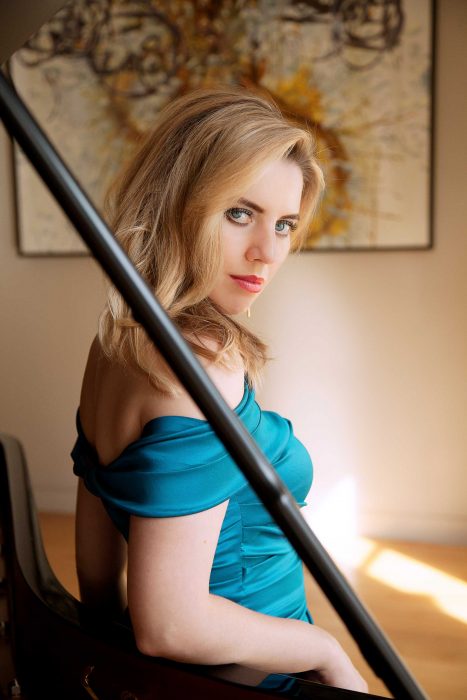Retooled chamber program brings virtuosic rewards at FIU Music Festival

The Borodin Quartet cancelled its fall American tour due to one of its members having to undergo emergency surgery.
Friends of Chamber Music director Julian Kreeger salvaged Sunday’s scheduled Borodin concert (a joint presentation with the FIU Music Festival) by engaging a diverse group of artists and putting together an engaging afternoon musicale.
Two monumental works of the solo keyboard repertoire shared the bill with two woodwind rarities. All of the music proved well worth hearing and the performers were all impressive exponents of their instruments.
Maxim Rubtsov, principal flute of the Russian National Orchestra, led off the program at the Wertheim Performing Arts Center with the Flute Concerto No. 1 by Vladimir Tysbin (1877-1949). An old-fashioned showpiece steeped in Russian romantic nostalgia, the ten-minute score demonstrated Rubtsov’s stellar technique. In the final section, his rapid-fire runs were thrown off with élan, drawing immediate bravos at the final flourish.
Rubtsov was accompanied by Anastasiya Naplekova, a faculty member at the University of Florida and graduate of the UM Frost School of Music where she studied with Santiago Rodriguez. Playing with the lid closed on the excellent Steinway, Naplekiova still conveyed big-boned power while remaining attentive to the Rubtsov’s sudden turns and changes of meter.
Rubtsov is a born showman as well as a bravura instrumentalist. As he began his encore, he played one note; then stopped, slyly grinning before launching into Rimsky-Korsakov’s Flight of the Bumble Bee at top speed without sacrificing accuracy.
Alexander Fiterstein has appeared numerous times on Friends of Chamber Music concerts, often exploring less familiar clarinet repertoire. Saint-Saëns’ Clarinet Sonata proved a winning confection. Two slow movements are contrasted with two fast and breezy sections in the manner of Chaminade’s flute Concertino.
The sonata opens with a beguiling theme which Fiterstein assayed with his trademark mellow sound and sustained legato. phrasing. Saint-Saëns knew a good tune when he wrote one and brings the melody back at the work’s conclusion. Fiterstein’s low register took center stage in the third movement funeral march. Accompanied by solemn piano chords, the sheer richness of his sonority filled the hall. The speedy dexterity and ease of his leaping between registers in the flashy segments demonstrated his mastery of the instrument’s extremes. Natasha Paremski, the concert’s featured pianist, was a subtle and musically flexible partner.
Paremski is a keyboard powerhouse with the type of monster technique that can conquer the most treacherous minefields of the literature. Ravel’s Gaspard de la nuit proved her most persuasive offering. Paremski’s delicately etched pastels, mercurial rhythms and wide dynamic range adroitly captured the impressionistic portrait of the water nymph in “Ondine.” Her atmospheric shading painted the misty haze of the desert scene “Le Gibet.” “Scarbo” is considered one of the most difficult piano works ever written but Paremski tossed off the torrents of notes like child’s play. Her capricious phrasing and fiery volleys across the keyboard conveyed both the humor and scariness of the night goblin.
Paremski’s reading of Mussorgsky’s Pictures at an Exhibition was equally impressive technically and frequently exciting. Still her abrupt shifts of volume and tempo at times were over the top.
From the first bars of the opening “Promenade,” it was obvious that this was going to be a personalized view of Mussorgsky’s gallery. Paremski’s best playing was often in the quiet moments like the second statement of the promenade theme, “The Old Castle” and the mystery and terror of “The Catacombs.” She may have set a speed record for “Ballet of the Unhatched Chickens” but the tempo seemed rushed and breathless. “Bydlo” (Cattle) was simply way too loud. In “Samuel Goldenberg and Schmuÿle” Paremski effectively brought out the arrogance of the businessman in clipped, terse phrases while the beggars pleading sounded almost like a Russian orthodox chant.
Her hands flew in a relentless blur across the keys in the penultimate “Baba Yaga,” a portrait of a witch that was fearsome indeed. “The Great Gate at Kiev” finale emerged in stately fashion. Paremski unleashed her full power arsenal only at the climaxes but the whispered eloquence of the central hymn was unusually emphatic. If Paremski’s performance of Mussorsky’s vignettes was fitfully bombastic, it was consistently fascinating and played with blazing fire.
The FIU Festival presents the Amernet Quartet and cellist Julian Schwarz playing an all-Beethoven program featuring the String Quartet No. 10 in A Major and arrangements of the Piano Sonata No. 15 in D Major (“Pastorale”) and Violin Sonata No. 9 in A Major 7:30 p.m. Thursday at the FIU Wertheim Performing Arts Center. calendar.fiu.edu
Posted in Performances
Leave a Comment
Mon Nov 4, 2019
at 12:47 pm
No Comments